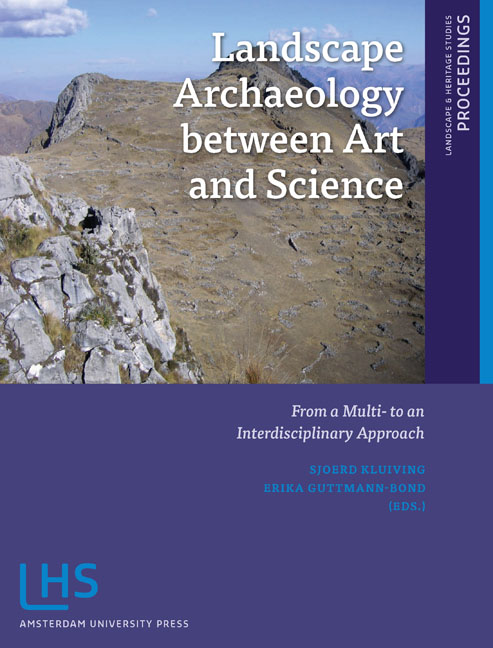Book contents
- Frontmatter
- Contents
- Preface
- Introduction: LAC2010: First International Landscape Archaeology Conference
- THEME 1 HOW DID LANDSCAPE CHANGE?
- THEME II IMPROVING TEMPORAL, CHRONOLOGICAL AND TRANSFORMATIONAL FRAMEWORKS
- THEME III LINKING LANDSCAPES OF LOWLANDS TO MOUNTAINOUS AREAS
- THEME IV APPLYING CONCEPTS OF SCALE
- THEME V NEW DIRECTIONS IN DIGITAL PROSPECTION AND MODELLING TECHNIQUES
- THEME VI HOW WILL LANDSCAPE ARCHAEOLOGY DEVELOP IN THE FUTURE?
- Miscellaneous Endmatter
2.4 - Geo- and Landscape Archaeological Investigations in south-western Lazio (Italy): An Approach for the Identification of man-made Landscape Transformation Processes in the Hinterland of Rome
Published online by Cambridge University Press: 21 January 2021
- Frontmatter
- Contents
- Preface
- Introduction: LAC2010: First International Landscape Archaeology Conference
- THEME 1 HOW DID LANDSCAPE CHANGE?
- THEME II IMPROVING TEMPORAL, CHRONOLOGICAL AND TRANSFORMATIONAL FRAMEWORKS
- THEME III LINKING LANDSCAPES OF LOWLANDS TO MOUNTAINOUS AREAS
- THEME IV APPLYING CONCEPTS OF SCALE
- THEME V NEW DIRECTIONS IN DIGITAL PROSPECTION AND MODELLING TECHNIQUES
- THEME VI HOW WILL LANDSCAPE ARCHAEOLOGY DEVELOP IN THE FUTURE?
- Miscellaneous Endmatter
Summary
ABSTRACT
The landscape of south-western Lazio is studied in a combined geo- and settlement archaeological approach, focusing on the changes caused by humans in the Roman Republican and Imperial Age. First results of a brief, non invasive assessment of the nature and extent of man-made landscape alterations in a part of the suburban hinterland of Rome are presented and the methodological frame of the approach is outlined.
KEYWORDS
geoarchaeology, Settlement Archaeology, gis, Republican and Imperial Rome, Central Italy, Lazio
INTRODUCTION
The relation of man to his surrounding environment and the diachronic, dynamic changes of settlement patterns on a regional scale are key aspects for the understanding of past landscapes. These aspects are central issues on the research agenda of a project focusing on the Roman Republican and Imperial Era in central Italy, for which geoarchaeological field research is combined with GIS based analysis of settlement site preference factors.
The study area is situated in south-western Lazio, the immediate hinterland of Rome (fig.1). A geoarchaeological overview survey was conducted in 2009, mainly focusing on the area between the Alban hills and the Astura River, therefore the northern part of the overall study area, which reaches from Rome and Ostia to Terracina and from the Tyrrhenian Sea to the Alban Hills and Lepini an Ausoni Mountains. This paper introduces this particular aspect of the project outlining the chosen approach and presenting first results.
SCIENTIFIC OBJECTIVES
The main objective of the geoarchaeological research was to gain an overview on quality and quantity of human-induced landscape transformation processes in the past within the study area. While all stages of human action may have affected the formation of erosional deposits in one way or the other, the particular focus was on the Period of Roman Antiquity, for which the settlement patterns and settlement dynamics are studied as part of the wider project.
The type and the quantity of erosion may be used as an indicator to questions as: Did deforestation take place? Was the land used for pasture or farming? Was the use of the landscape sustainable or did the land use deteriorate the former conditions significantly?
- Type
- Chapter
- Information
- Landscape Archaeology between Art and ScienceFrom a Multi- to an Interdisciplinary Approach, pp. 211 - 222Publisher: Amsterdam University PressPrint publication year: 2012



